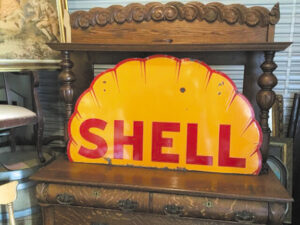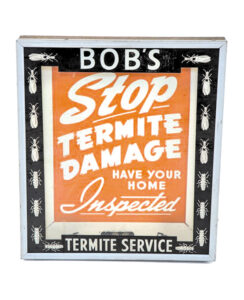 By Anne Gilbert
By Anne Gilbert Would you hang a huge tin sign depicting a yellow Shell gasoline product in your living room? These days the concept of what is collectible has changed. Check out the TV show “Flea Market Flips” and you are in for a surprise. Prices are often in the high hundreds.
Late 19th and early 20th century advertising signs first became hot collectibles in the 1970s. Interest grew and once flea market bargains found their way into private collections and as decorations for theme restaurants. These days they are considered as decorative accessories. Prices for some can be thousands of dollars.
Dealers became aware of the collecting potential of 1920s and 1930s gas station signs. “Urban Trade Remains” in Chicago began selling them in 2006 and is still in business. They don’t have to be old to be costly. In fact they can be of such humble materials as cardboard or tin.
While most 19th century trade signs are in museums periodically an example will show up at a high end auction house like Skinner or Sothebys’. If a sign can be attributed to a famous 20th century illustrator the price zooms.
Historically trade signs were first used in America on the coastal settlements of New England, Philadelphia and Virginia. By the mid 19th century many talented artists and carvers supplemented their incomes making trade signs. Among them Edward Hicks famed for his Peaceable Kingdom animal paintings. The purpose wasn’t merely to attract customers but to help the many people who couldn’t read and identify what the shopkeeper was offering. They were often figural, such as a pair of spectacles for an optometrist.
 CLUES: If you like the look of 19th century figural trade signs there are reproductions. However, there are a wide variety of vintage trade signs at affordable prices.
CLUES: If you like the look of 19th century figural trade signs there are reproductions. However, there are a wide variety of vintage trade signs at affordable prices. When it comes to vintage, however, age, rarity and quality of art are important factors determining the price. However, significant changes during the 1930s in materials created an entirely new category: Neon signs. Currently a neon tube sign can fetch $1,400 or more in a retail setting.
Metal gas station signs from the 1930s are considered collectible rarities. A double-side Shell gasoline sign can also be priced at $1,400.
Should you buy a damaged but unique example? At a past auction several cardboard and paper signs had been professionally restored. A professionally restored Du Pont “E.C.” and “Schultz” shotgun shell lithograph sold over estimate for $2,875. Helping the value was the fact that the flock of ducks were illustrated by Lynn Bogue Hunt, famed illustrator.
Subjects with popular of historical interest can also effect the price. An example would be women competing in sports with men in the early 20th century.
PHOTO CAPTION: 1930s neon sign. CREDIT: Urban remains, Chicago, IL. PHOTO CAPTION: Double side Shell gasoline sign CREDIT: hiddentreasuresut.com















Follow Us